Gochujang Butter Salmon: Prepare to elevate your salmon game with a flavor explosion that will leave you craving more! Imagine perfectly flaky salmon, infused with the fiery kick of gochujang and the rich, creamy indulgence of butter. This isn’t just dinner; it’s an experience.
Gochujang, a fermented Korean chili paste, has been a staple in Korean cuisine for centuries. Its complex flavor profile a blend of sweet, savory, and spicy adds depth and character to any dish. While traditionally used in stews, marinades, and sauces, its recent surge in popularity has led to exciting culinary innovations, like this delectable salmon recipe.
What makes Gochujang Butter Salmon so irresistible? It’s the perfect balance of flavors and textures. The gochujang provides a delightful heat that’s tempered by the buttery richness, creating a symphony of taste that dances on your palate. The salmon, cooked to perfection, offers a tender, flaky texture that complements the sauce beautifully. Plus, it’s incredibly quick and easy to prepare, making it a weeknight winner. Whether you’re a seasoned chef or a kitchen novice, this recipe is guaranteed to impress. Get ready to discover your new favorite way to enjoy salmon!
Ingredients:
- For the Salmon:
- 4 (6-ounce) salmon fillets, skin on or off
- 1 tablespoon olive oil
- Salt and freshly ground black pepper, to taste
- For the Gochujang Butter:
- 4 tablespoons unsalted butter, softened
- 2 tablespoons gochujang (Korean chili paste)
- 1 tablespoon honey or maple syrup
- 1 tablespoon rice vinegar
- 1 clove garlic, minced
- 1/2 teaspoon grated ginger
- 1/4 teaspoon red pepper flakes (optional, for extra heat)
- For Serving (Optional):
- Cooked rice or quinoa
- Steamed broccoli or asparagus
- Sesame seeds, for garnish
- Chopped green onions, for garnish
- Lime wedges, for serving
Preparing the Gochujang Butter:
Alright, let’s get started with the star of the show the Gochujang Butter! This stuff is seriously addictive, and you’ll want to put it on everything. Trust me on this one.
- Soften the Butter: Make sure your butter is nice and soft. You can leave it out at room temperature for about 30 minutes to an hour, or if you’re in a hurry, you can microwave it for a few seconds (but be careful not to melt it!). You want it soft enough to easily mix with the other ingredients.
- Combine Ingredients: In a medium bowl, add the softened butter, gochujang, honey (or maple syrup), rice vinegar, minced garlic, grated ginger, and red pepper flakes (if using).
- Mix Well: Use a fork or a small whisk to thoroughly combine all the ingredients. You want everything to be evenly distributed, so you don’t get a big clump of gochujang in one bite. Keep mixing until the butter is a beautiful, vibrant red color and everything is smooth and creamy.
- Taste and Adjust: Now, the most important part taste it! This is where you can customize the flavor to your liking. If you want it sweeter, add a little more honey or maple syrup. If you want more tang, add a splash more rice vinegar. And if you’re a spice fiend like me, add a pinch more red pepper flakes.
- Set Aside: Once you’re happy with the flavor, set the Gochujang Butter aside. You can leave it at room temperature if you’re going to use it right away, or you can store it in the refrigerator for later. If you refrigerate it, just let it soften a bit before using.
Preparing the Salmon:
Now that our Gochujang Butter is ready to rock, let’s move on to the salmon. The key here is to not overcook it nobody likes dry salmon!
- Prepare the Salmon: Pat the salmon fillets dry with paper towels. This helps them get a nice sear. If you bought salmon with the skin on, you can leave it on or remove it it’s totally up to you. I personally like the crispy skin, but it’s not for everyone.
- Season the Salmon: Drizzle the salmon fillets with olive oil and season generously with salt and freshly ground black pepper. Don’t be shy with the seasoning it really brings out the flavor of the salmon.
Cooking the Salmon:
There are a few different ways you can cook the salmon pan-searing, baking, or grilling. I’m going to walk you through pan-searing, which is my favorite method because it’s quick and easy, and you get that beautiful crispy skin (if you left it on).
- Heat the Pan: Heat a tablespoon of olive oil in a large skillet over medium-high heat. You want the pan to be nice and hot before you add the salmon. A good way to test if the pan is hot enough is to flick a drop of water into it if it sizzles and evaporates immediately, you’re good to go.
- Sear the Salmon: Carefully place the salmon fillets in the hot pan, skin-side down (if using). Sear for about 4-5 minutes, or until the skin is crispy and golden brown. Don’t move the salmon around while it’s searing you want it to develop a nice crust.
- Flip and Cook: Flip the salmon fillets and cook for another 3-4 minutes, or until the salmon is cooked through. The internal temperature should reach 145°F (63°C). You can use a meat thermometer to check the temperature, or you can simply flake the salmon with a fork to see if it’s cooked through. It should be opaque and slightly firm to the touch.
- Add the Gochujang Butter: Reduce the heat to low and add the Gochujang Butter to the pan. Let it melt and coat the salmon fillets. Spoon the melted butter over the salmon for a minute or two, until it’s nicely glazed.
Baking the Salmon (Alternative Method):
If you prefer baking, here’s how to do it:
- Preheat the Oven: Preheat your oven to 400°F (200°C).
- Prepare Baking Sheet: Line a baking sheet with parchment paper. This makes cleanup a breeze!
- Place Salmon: Place the seasoned salmon fillets on the prepared baking sheet.
- Bake: Bake for 12-15 minutes, or until the salmon is cooked through and flakes easily with a fork. The internal temperature should reach 145°F (63°C).
- Add Gochujang Butter: Once the salmon is cooked, remove it from the oven and spread the Gochujang Butter evenly over the fillets. You can broil it for a minute or two to caramelize the butter slightly, but watch it carefully so it doesn’t burn.
Grilling the Salmon (Alternative Method):
For a smoky flavor, grilling is a fantastic option:
- Prepare the Grill: Preheat your grill to medium-high heat. Make sure the grates are clean and lightly oiled to prevent sticking.
- Place Salmon: Place the seasoned salmon fillets on the grill, skin-side down (if using).
- Grill: Grill for 4-6 minutes per side, or until the salmon is cooked through and flakes easily with a fork. The internal temperature should reach 145°F (63°C).
- Add Gochujang Butter: During the last minute of grilling, spread the Gochujang Butter over the salmon, allowing it to melt and glaze the fish.
Serving the Gochujang Butter Salmon:
Okay, the salmon is cooked, the Gochujang Butter is melted and glistening it’s time to eat! Here are a few serving suggestions:
- Serve Immediately: Serve the Gochujang Butter Salmon immediately while it’s hot and delicious.
- Pair with Sides: I love serving this salmon with cooked rice or quinoa to soak up all that delicious sauce. Steamed broccoli or asparagus are also great side dishes.
- Garnish: Garnish with sesame seeds and chopped green onions for a pop of color and flavor.
- Lime Wedges: Serve with lime wedges for a little extra zing.
Tips and Variations:
- Spice Level: Adjust the amount of gochujang and red pepper flakes to control the spice level.
- Sweetness: Use honey or maple syrup depending on your preference. You can also use brown sugar for a richer flavor.
- Vegetables: Add some sliced bell peppers or onions to the pan while cooking the salmon for a complete meal.
- Leftovers: Leftover Gochujang Butter Salmon can be stored in the refrigerator for up to 3 days. Reheat gently in the microwave or oven.

Conclusion:
This Gochujang Butter Salmon isn’t just another fish recipe; it’s a flavor explosion waiting to happen, and trust me, you absolutely need to experience it. The sweet, savory, and subtly spicy dance of the gochujang butter glaze creates a truly unforgettable meal that’s surprisingly simple to prepare. From the initial sizzle in the pan to the final, satisfying bite, this dish is a winner. I’ve made it countless times, and it’s always a crowd-pleaser, even for those who aren’t typically salmon fans. Why is this a must-try? Because it elevates salmon from a weeknight staple to a restaurant-worthy experience in under 30 minutes. The gochujang butter sauce is the star, transforming the naturally rich flavor of the salmon into something truly special. It’s the perfect balance of sweet, spicy, and umami, creating a complex and deeply satisfying taste that will leave you wanting more. Plus, it’s incredibly versatile!Serving Suggestions and Variations:
I love serving this Gochujang Butter Salmon over a bed of fluffy white rice, allowing the sauce to soak in and create a delicious, flavorful base. Steamed broccoli or asparagus are excellent side dishes, providing a healthy and vibrant contrast to the richness of the salmon. For a more complete meal, consider adding a side of quinoa or roasted sweet potatoes. But don’t stop there! Feel free to experiment with variations to suit your own taste. If you prefer a milder flavor, reduce the amount of gochujang paste. For an extra kick, add a pinch of red pepper flakes. A squeeze of fresh lime juice at the end brightens up the flavors and adds a touch of acidity. You could also try grilling the salmon instead of pan-searing it for a smoky flavor. Another fantastic variation is to use this gochujang butter sauce on other types of seafood, such as shrimp or scallops. It would also be delicious on chicken or even tofu for a vegetarian option. The possibilities are endless! I’ve also found that a sprinkle of toasted sesame seeds and some thinly sliced green onions add a beautiful visual appeal and a subtle nutty flavor. A side of kimchi is also a fantastic addition, complementing the Korean flavors of the dish perfectly. Don’t be afraid to get creative and make this recipe your own. That’s the beauty of cooking it’s all about experimenting and finding what you love. So, what are you waiting for? Grab your ingredients and get cooking! I promise you won’t be disappointed. This Gochujang Butter Salmon is a guaranteed hit, and I’m confident that it will become a regular part of your meal rotation. I’m so excited for you to try this recipe! Once you do, please come back and share your experience in the comments below. I’d love to hear what you think, what variations you tried, and how you served it. Your feedback is invaluable and helps me continue to create delicious and easy-to-follow recipes. Happy cooking! Print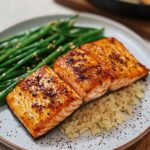
Gochujang Butter Salmon: A Delicious & Easy Recipe
- Total Time: 25 minutes
- Yield: 4 servings 1x
Description
Flaky salmon fillets glazed with a vibrant and flavorful homemade gochujang butter. A quick and easy weeknight meal with a Korean-inspired kick!
Ingredients
- 4 (6-ounce) salmon fillets, skin on or off
- 1 tablespoon olive oil
- Salt and freshly ground black pepper, to taste
- 4 tablespoons unsalted butter, softened
- 2 tablespoons gochujang (Korean chili paste)
- 1 tablespoon honey or maple syrup
- 1 tablespoon rice vinegar
- 1 clove garlic, minced
- 1/2 teaspoon grated ginger
- 1/4 teaspoon red pepper flakes (optional, for extra heat)
- Cooked rice or quinoa
- Steamed broccoli or asparagus
- Sesame seeds, for garnish
- Chopped green onions, for garnish
- Lime wedges, for serving
Instructions
- Prepare the Gochujang Butter: In a medium bowl, combine softened butter, gochujang, honey (or maple syrup), rice vinegar, minced garlic, grated ginger, and red pepper flakes (if using). Mix well until smooth and creamy. Taste and adjust seasonings as needed. Set aside.
- Prepare the Salmon: Pat the salmon fillets dry with paper towels. Drizzle with olive oil and season generously with salt and pepper.
- Pan-Searing Method:
- Heat a tablespoon of olive oil in a large skillet over medium-high heat.
- Carefully place the salmon fillets in the hot pan, skin-side down (if using). Sear for about 4-5 minutes, or until the skin is crispy and golden brown.
- Flip the salmon fillets and cook for another 3-4 minutes, or until the salmon is cooked through (internal temperature of 145°F/63°C).
- Reduce the heat to low and add the Gochujang Butter to the pan. Let it melt and coat the salmon fillets. Spoon the melted butter over the salmon for a minute or two, until it’s nicely glazed.
- Baking Method:
- Preheat oven to 400°F (200°C).
- Line a baking sheet with parchment paper.
- Place the seasoned salmon fillets on the prepared baking sheet.
- Bake for 12-15 minutes, or until the salmon is cooked through and flakes easily with a fork (internal temperature of 145°F/63°C).
- Remove from oven and spread the Gochujang Butter evenly over the fillets. You can broil it for a minute or two to caramelize the butter slightly, but watch it carefully so it doesn’t burn.
- Grilling Method:
- Preheat your grill to medium-high heat. Make sure the grates are clean and lightly oiled to prevent sticking.
- Place the seasoned salmon fillets on the grill, skin-side down (if using).
- Grill for 4-6 minutes per side, or until the salmon is cooked through and flakes easily with a fork (internal temperature of 145°F/63°C).
- During the last minute of grilling, spread the Gochujang Butter over the salmon, allowing it to melt and glaze the fish.
- Serving: Serve the Gochujang Butter Salmon immediately with cooked rice or quinoa, steamed broccoli or asparagus, sesame seeds, chopped green onions, and lime wedges.
Notes
- Adjust the amount of gochujang and red pepper flakes to control the spice level.
- Use honey or maple syrup depending on your preference. You can also use brown sugar for a richer flavor.
- Add some sliced bell peppers or onions to the pan while cooking the salmon for a complete meal.
- Leftover Gochujang Butter Salmon can be stored in the refrigerator for up to 3 days. Reheat gently in the microwave or oven.
- Prep Time: 10 minutes
- Cook Time: 10 minutes


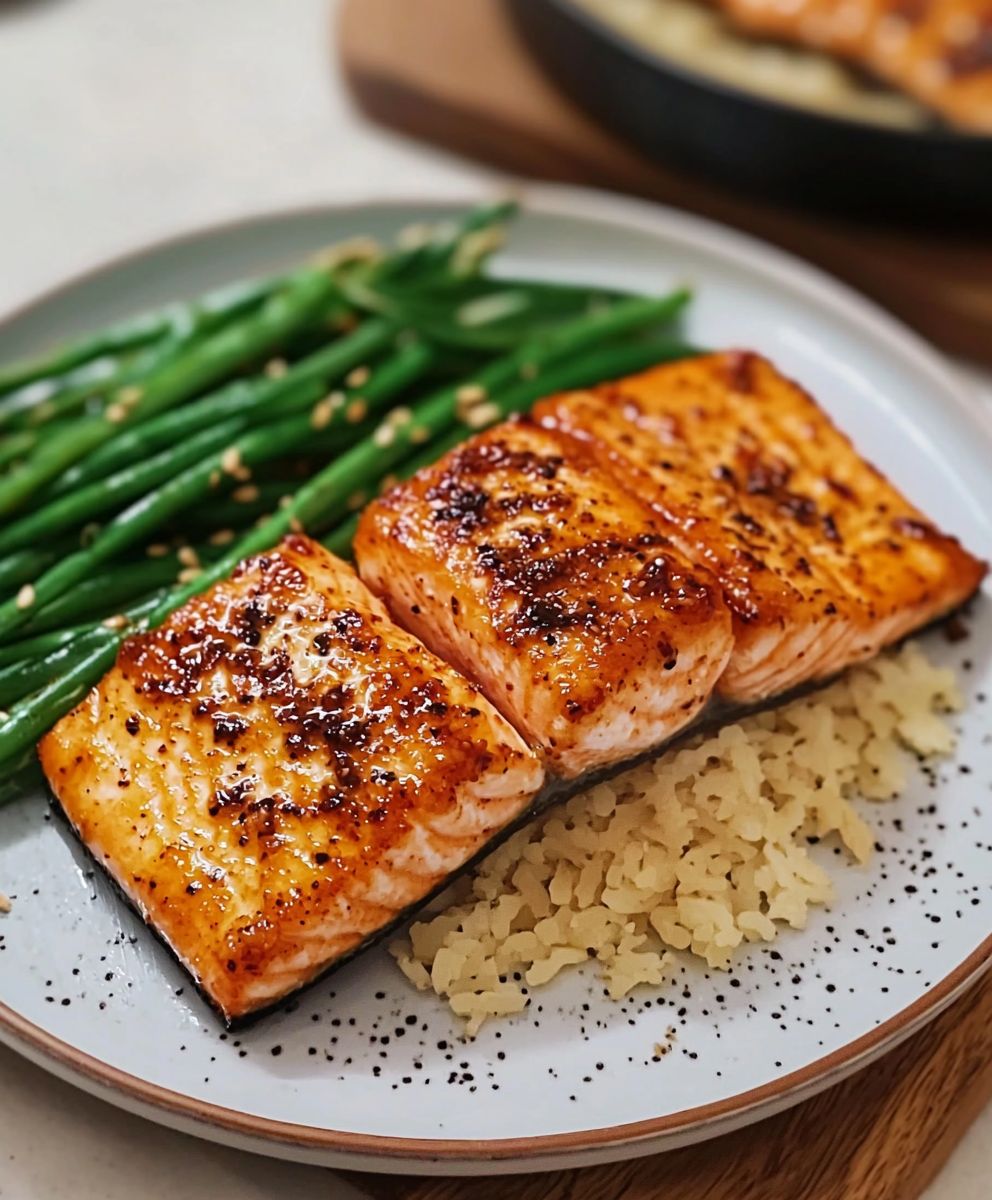
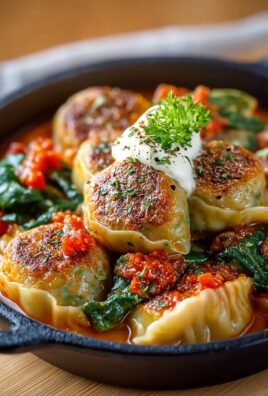
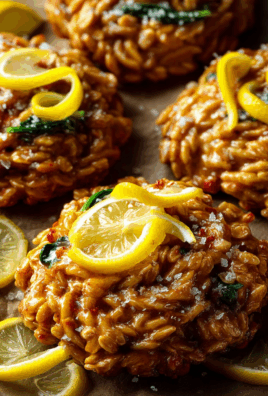
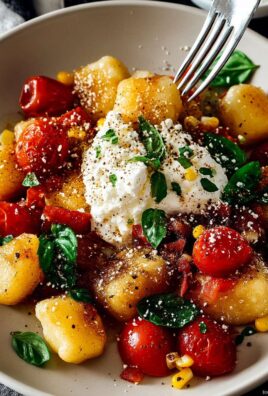
Leave a Comment